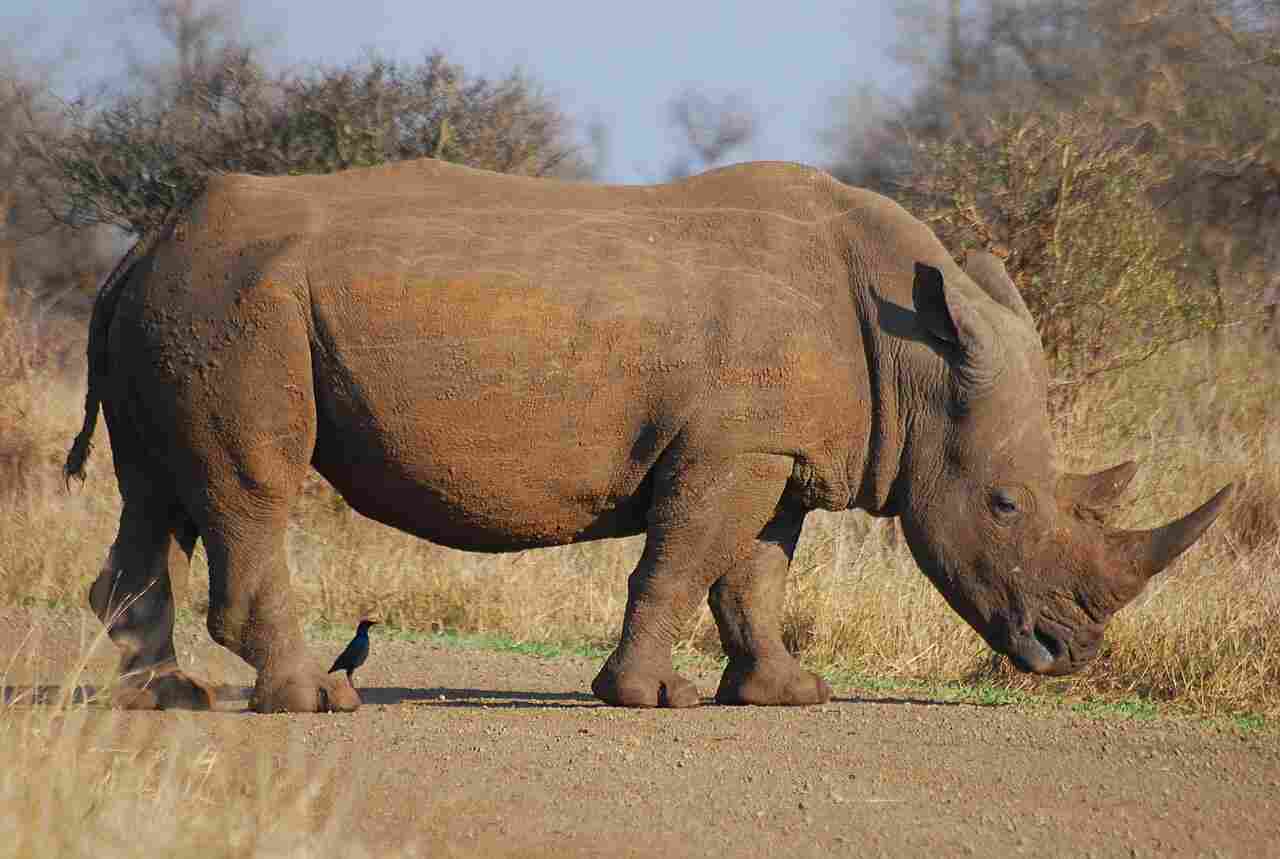Hippo Vs Rhino Size, Weight, Ecological Comparison
In open land, rhinos have the advantage over hippos due to their larger size, greater strength, and sharp tusks. They are also faster and have thick skin for protection. However, in wetland areas, hippos may have the upper hand with their powerful teeth and higher aggressiveness. This article explores the biological and physical comparisons between these two large animals.
Key Outcomes
*Biological Comparison
While both hippos and rhinos belong to the order Artiodactyla, they are not closely related in terms of genus and species. Hippos belong to the family Hippopotamidae, while rhinos belong to the family Rhinocerotidae. Despite this, there are some interesting similarities and differences to consider.
*Size and Weight Comparison
In terms of size, rhinos are generally larger than hippos. The average size of a rhino can range from 10 to 13 feet in length, while hippos typically measure around 10 to 15 feet long. Additionally, rhinos can stand up to 6 feet tall at the shoulder, whereas hippos reach a height of about 4 to 5 feet.
When it comes to weight, hippos have the advantage, although the heaviest rhinos are heavier than the heaviest hippos. An adult rhino can weigh anywhere between 2,000 to 3,000 pounds, with some species reaching up to 5,000 pounds. On the other hand, hippos weigh between 3,000 to 4,500 pounds.
*Physical Capability Comparison
Rhinos are generally stronger than hippos due to their superior size and build, among other factors. Rhinos have a larger body mass and more muscular build, which gives them greater physical power (although they are not generally heavier).
Their size and build advantage allows them to exert more force and have a stronger impact in various activities such as charging, fighting, and defending themselves.
1). Taxonomy
The taxonomy of hippos and rhinos reveals interesting similarities and differences between the two animals. Both hippos and rhinos belong to the same order, Perissodactyla, which includes odd-toed ungulates. However, they belong to different families. Hippos are classified under the family Hippopotamidae, while rhinos are classified under the family Rhinocerotidae.
In terms of genus and species, hippos are classified as Hippopotamus amphibius, while rhinos have several different species, including the white rhinoceros (Ceratotherium simum) and the black rhinoceros (Diceros bicornis). This distinction in species highlights the diversity within the rhino family.
When comparing the two animals, it is important to note that their taxonomy reflects their evolutionary history and genetic relationships. While they share some common characteristics as perissodactyls, their distinct families and species highlight their unique adaptations and ecological niches.
2). Appearance
When comparing the appearance of hippos and rhinos, there are several notable differences. Starting with their coats, hippos have a hairless, tough skin that is prone to drying out. In contrast, rhinos have a thick, protective skin that is covered in a layer of hair. This difference in fur or skin texture is an adaptation to their respective habitats.
Another aspect of appearance is camouflage. Hippos have a grayish-brown skin color, which helps them blend in with their surroundings in the water. This camouflage allows them to remain hidden from potential predators. On the other hand, rhinos have a gray or brownish-gray coloration, which helps them blend in with the grasses and shrubs in their habitat.
In terms of stature and build, hippos are known for their large, barrel-shaped bodies with short legs. They have a bulky appearance, with a wide mouth and large jaws. Rhinos, on the other hand, have a more compact and robust build, with a distinctive horn on their nose. Their body shape is adapted for charging and defending themselves against threats.
3). Size
When comparing the size of hippos and rhinos, there are significant differences in their total body length and height at the shoulders. Hippos can reach an impressive length of up to 13 feet and stand around 5 feet tall at the shoulders. On the other hand, rhinos are generally larger, with a total body length ranging from 10 to 13 feet and a height at the shoulders of about 5 to 6 feet.
The size difference between these two animals is mainly due to their distinct body structures and adaptations. Hippos have a more elongated body shape, with a relatively shorter height at the shoulders.
This allows them to move swiftly through water and navigate their aquatic habitats with ease. In contrast, rhinos have a more compact and robust build, which contributes to their overall larger size. This body structure is advantageous for their terrestrial lifestyle and helps them withstand potential threats.
It’s important to note that the size of both hippos and rhinos can vary depending on the species and individual factors. For example, the common hippopotamus tends to be larger than the pygmy hippopotamus, while the white rhinoceros is generally larger than the black rhinoceros.
4). Weight
On average, both hippos and rhinos have a similar weight, but hippos are generally heavier than rhinos. White rhinos are notably large, and tend to be heavier than most hippos.
The average weight of a hippo can range from 3,000 to 4,500 kilograms (6,600 to 9,900 pounds). These massive creatures have a dense body structure, with a thick layer of fat that helps them stay buoyant in water and provides insulation. Their weight is distributed evenly throughout their bodies, making them well-suited for their semi-aquatic lifestyle.
White rhinos are known for their impressive size and weight. They can weigh anywhere between 1,800 to 2,700 kilograms (4,000 to 6,000 pounds). The white rhinoceros is the largest rhino species and has a robust build, with a broad chest and powerful legs. This extra weight is advantageous for their terrestrial lifestyle, as it allows them to exert force and defend themselves against potential threats.
It’s important to note that the weight of both hippos and rhinos can vary depending on factors such as age, sex, and individual health. Additionally, different species of rhinos may have varying weight ranges. For example, the black rhinoceros is generally smaller and lighter compared to the white rhinoceros.

5). Bite Force
When comparing the bite force of hippos and rhinos, it is evident that both animals possess impressive jaw strength. The bite force of an animal is measured in pounds per square inch (psi), which indicates the amount of pressure exerted by their jaws.
Hippos have a formidable bite force, with an average psi ranging from 1,100 to 1,800. This allows them to crush through tough vegetation, such as water hyacinths and grasses, as well as defend themselves against potential threats. Their strong jaws and large incisors enable them to deliver powerful bites when necessary.
On the other hand, rhinos also possess a significant bite force. Although specific psi measurements for rhinos are not readily available, their large teeth allow them to graze on tough plants and browse on branches. Rhinos primarily use their bite force for feeding purposes, as they are herbivores and rely on their teeth to tear and grind vegetation.
6). Overall Physical Capacity
Rhinos are heavier and generally stronger than hippos.
They have a clear advantage in terms of size and weight. Rhinos are larger than hippos. This superior size and build give rhinos a greater ability to exert force and withstand pressure, making them formidable creatures in the animal kingdom.
In a violent confrontation between a hippo and a rhino, the rhino’s superior size and build would likely give it the upper hand, but the hippo’s weight, aggression, and teeth pose a significant threat. However, it is important to note that such confrontations are rare in the wild, as these animals tend to avoid direct conflicts whenever possible.
Despite the rhino’s physical advantage, hippos should not be underestimated. They possess their own unique physical capabilities, such as their powerful jaws and strong incisors, which allow them to deliver formidable bites. Additionally, hippos are known for their agility and speed in water, making them highly adapted to their aquatic habitats.
7). Habitat
Hippos are primarily found in sub-Saharan Africa, where they inhabit rivers, lakes, and swamps. They are semi-aquatic creatures and spend most of their time in water to keep their bodies cool and protected from the sun. Hippos are well-adapted to their aquatic habitats, with their barrel-shaped bodies, webbed feet, and eyes and nostrils positioned on the top of their heads, allowing them to stay submerged while still being able to see and breathe.
On the other hand, rhinos are found in various habitats across Africa and Asia, including grasslands, savannas, and forests. They are terrestrial animals and are well-suited to their environments. Rhinos have thick, armored skin that protects them from predators and thorny vegetation. They also have a keen sense of smell, which helps them navigate their surroundings and locate food sources.
While both hippos and rhinos have adapted to their respective habitats, it is important to note that their geographic ranges do not overlap significantly. Hippos are mainly found in Africa, while rhinos are found in both Africa and Asia.
8). Lifespan
The lifespan of hippos is generally longer than that of rhinos. Hippos have an average lifespan of around 40 to 50 years in the wild, although some individuals have been known to live up to 60 years. On the other hand, rhinos have a slightly shorter lifespan, with most species living between 35 and 45 years in the wild.
Several factors contribute to the differences in lifespan between these two animals. One key factor is their size and weight. Hippos are larger and heavier than rhinos, which may contribute to their longer lifespan. Additionally, hippos have a more herbivorous diet, consisting mainly of grasses, while rhinos are primarily herbivores but may also consume leaves, fruits, and bark. This difference in diet may also play a role in their lifespan.
Another factor to consider is the level of threat they face from predators and human activities. Hippos, being semi-aquatic, are less vulnerable to predation compared to rhinos, which are terrestrial animals. Rhinos, particularly the critically endangered species, face significant threats from poaching and habitat loss, which can impact their lifespan.
9). Behavior
In terms of feeding, both hippos and rhinos are herbivores, but they have different dietary preferences. Hippos mainly feed on grasses, while rhinos have a more varied diet that includes leaves, fruits, and bark. This difference in diet may influence their behavior and interactions with their environment.
Aggression is another important aspect to consider. Hippos are known for their territorial and aggressive behavior, especially when it comes to defending their territory or young. Rhinos, on the other hand, are generally more solitary and less aggressive, although they can become aggressive if they feel threatened.
Vocalization is a means of communication for both hippos and rhinos. Hippos produce a variety of vocalizations, including grunts, roars, and snorts, which they use to communicate with each other. Rhinos also vocalize, but their vocalizations are generally less varied and more limited in range.
Social behavior differs between the two animals as well. Hippos are highly social animals and live in groups called pods, which can consist of up to 30 individuals. Rhinos, on the other hand, are more solitary and tend to have smaller social groups, usually consisting of a mother and her offspring.
When it comes to parenting, both hippos and rhinos exhibit protective behavior towards their young. Hippos are known to be highly protective of their calves and will aggressively defend them against any potential threats. Rhinos also show maternal care and will protect their young from predators.
Overall, while both hippos and rhinos share some similarities in behavior, such as being herbivores and exhibiting protective parenting behavior, there are notable differences in terms of feeding preferences, aggression, vocalization, and social behavior.

10). Reproduction
Hippos are viviparous, which means they give birth to live young. The gestation period for hippos is around 8 months, and typically, a single calf is born. The female hippo will isolate herself from the rest of the pod during the birthing process to ensure the safety of her calf. This protective behavior is crucial as hippos face threats from predators such as crocodiles and lions.
On the other hand, rhinos are also viviparous, but their gestation period is longer, lasting around 15 to 16 months. Similar to hippos, rhinos usually give birth to a single calf. However, unlike hippos, rhinos do not isolate themselves during the birthing process. Instead, they continue to live within their social group, with other members providing protection and support.
When comparing the reproductive strategies of hippos and rhinos, it is evident that both species prioritize the safety and well-being of their offspring. However, the differences in gestation periods and isolation during birth highlight the unique adaptations each species has developed to ensure the survival of their young.
11). Danger Posed to Humans
When it comes to the danger posed to humans, the hippo is considered to be more dangerous due to its aggressive nature. Hippos are responsible for a significant number of human deaths each year, particularly in Africa where they are most commonly found. The sheer size and strength of a hippo, combined with its territorial behavior, make it a formidable threat to humans who come into contact with it.
On the other hand, while rhinos can be dangerous if provoked or threatened, they are generally less aggressive towards humans. Rhino attacks on humans are relatively rare compared to those involving hippos. However, it is important to note that any wild animal should be treated with caution and respect, as their behavior can be unpredictable.
If you happen to encounter a hippo or a rhino in the wild, it is crucial to take certain precautions to ensure your safety. Firstly, it is essential to maintain a safe distance and avoid any sudden movements that may provoke the animal. Secondly, it is advisable to stay quiet and avoid making any loud noises that could startle or agitate the animal. Lastly, it is crucial to follow the guidance of experienced guides or park rangers who are knowledgeable about the behavior and habits of these animals.

Hippo Vs Rhino: Aggressive Behavior is Less Present in Rhinos than Hippos (Credit: Wegmann 2009 .CC BY-SA 3.0.)
12). Conservation Status
The conservation status of both hippos and rhinos is a matter of concern due to the threats they face in the wild. Both species are classified as either endangered or threatened, highlighting the urgent need for conservation efforts to protect their populations.
For hippos, the main threats to their survival in the wild include habitat loss and degradation, as well as illegal hunting for their meat and ivory-like canine teeth. The destruction of wetland habitats, which are crucial for their survival, has significantly impacted hippo populations. Additionally, conflicts with humans, such as competition for resources and human-wildlife conflict, further exacerbate the challenges faced by hippos.
Similarly, rhinos also face significant threats to their survival. The main threats include poaching for their horns, habitat loss, and human-wildlife conflict. Rhino horns are highly sought after in illegal wildlife trade, driving the poaching crisis and posing a severe threat to their populations. Habitat loss, primarily due to agriculture and urbanization, further reduces suitable habitats for rhinos.
Efforts to conserve both species involve various strategies, including habitat protection, anti-poaching measures, and community engagement. Conservation organizations and governments work together to establish protected areas, implement stricter law enforcement, and raise awareness about the importance of these animals for ecosystems.

Are Hippos and Rhinos Related?
Both hippos and rhinos belong to the order Artiodactyla, which includes even-toed ungulates. This means that they share a common ancestor and are part of the same evolutionary lineage. However, they belong to different families within this order. Hippos belong to the family Hippopotamidae, while rhinos belong to the family Rhinocerotidae.
Despite their separate family classifications, hippos and rhinos do share some common characteristics. They both have large, bulky bodies and are herbivores, feeding on vegetation. Additionally, they are both semi-aquatic animals, spending a significant amount of time in water.
While hippos and rhinos may not be closely related in terms of family, their shared evolutionary history and similar adaptations have led to some striking similarities.
Conclusion
I). SIMILARITIES
Despite their separate family classifications, hippos and rhinos share several similarities. Both animals have large, bulky bodies and are herbivores, feeding on vegetation. They also have similar adaptations, such as being semi-aquatic and spending a significant amount of time in water. These shared characteristics can be attributed to their common evolutionary history as part of the order Artiodactyla.
II). DIFFERENCES
While hippos and rhinos have some similarities, there are also notable differences between the two animals. One key difference is their appearance. Hippos have a barrel-shaped body with short legs and a large head, while rhinos have a more compact body with a distinctive horn on their nose.
Another difference is their habitat. Hippos are primarily found in sub-Saharan Africa, inhabiting rivers, lakes, and swamps, while rhinos are found in various parts of Africa and Asia, inhabiting grasslands and forests.
In terms of size and weight, rhinos are generally larger and heavier than hippos.



